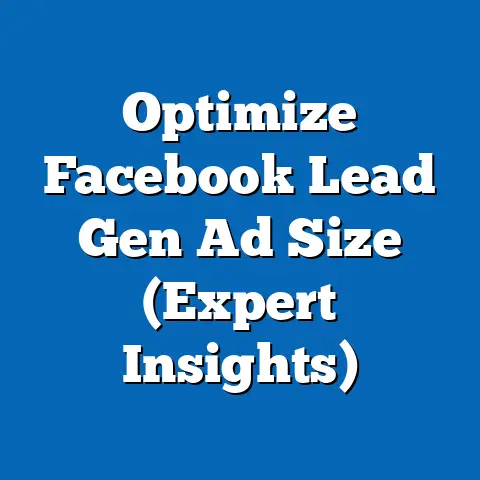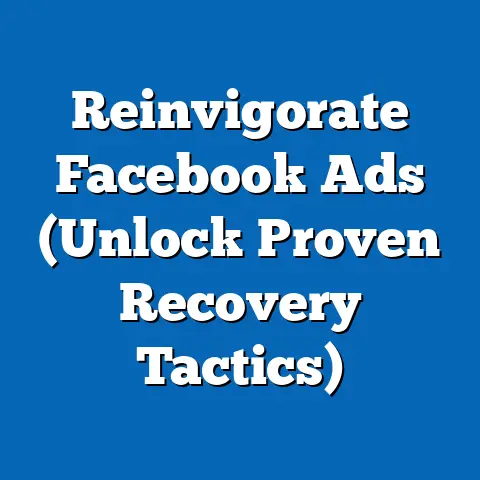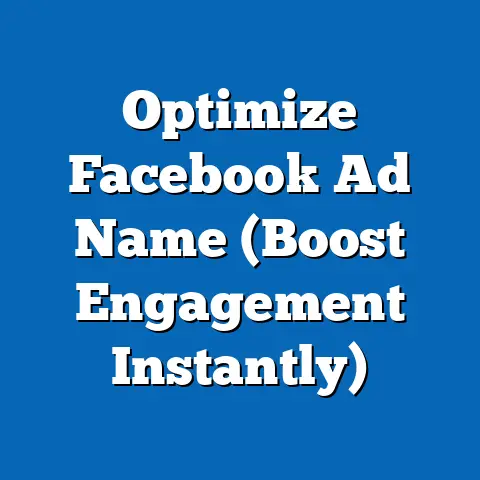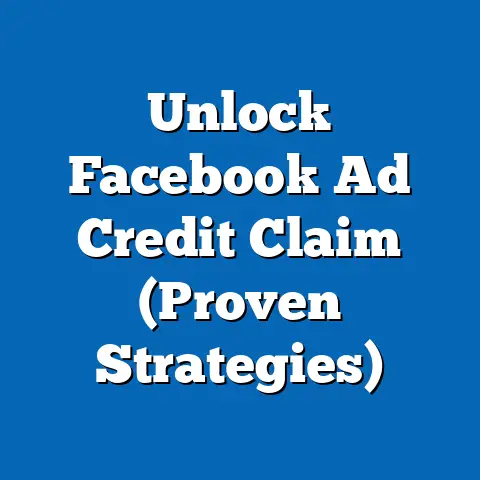Master Facebook Ad Automation (Unlock Efficiency Secrets)
In today’s fast-paced digital landscape, efficiency is the name of the game. As businesses, we’re constantly seeking ways to optimize our processes, reduce costs, and maximize our return on investment. When it comes to digital marketing, and specifically managing Facebook ads, this need for efficiency becomes even more crucial. We’re talking about juggling multiple campaigns, audiences, and ad creatives, all while keeping a close eye on performance metrics and making real-time adjustments. It’s a lot! But what if I told you there’s a powerful tool that can significantly streamline your Facebook advertising efforts? That tool is automation.
Automation, in the context of Facebook ads, isn’t about setting things on autopilot and walking away. It’s about strategically leveraging the platform’s features to handle repetitive tasks, optimize campaigns based on pre-defined rules, and ultimately, achieve better results with less manual effort. Think of it as having a highly efficient virtual assistant who’s always working behind the scenes to ensure your ads are performing at their best.
Expert Tip: Harness the Power of Automated Rules
One of the most effective strategies for maximizing the potential of Facebook ads is the implementation of automated rules. I’ve personally seen this make a massive difference in my own campaigns and for my clients. Automated rules allow you to set specific triggers that initiate actions based on performance metrics. For example, you can create a rule that automatically pauses an ad set if its cost per acquisition (CPA) exceeds a certain threshold, or increase the budget of a campaign that’s consistently generating a high return on ad spend (ROAS).
The beauty of automated rules is their versatility. They can be used for a wide range of scenarios, from optimizing bids and budgets to pausing underperforming ads and scaling successful ones. By automating these tasks, you free up your time to focus on higher-level strategic initiatives, such as developing compelling ad creatives, refining your targeting strategy, and analyzing overall campaign performance.
1. Understanding Facebook Ad Automation
So, what exactly does Facebook ad automation entail? At its core, it’s about using the platform’s built-in features to automate various aspects of your advertising campaigns. This can range from simple tasks like pausing ads based on performance to more complex strategies like dynamically generating personalized ads based on user behavior.
Facebook offers several key features for automation, including:
- Automated Rules: These are custom rules that you define to automatically take actions based on specific triggers and conditions.
- Dynamic Ads: These ads dynamically generate personalized content based on a user’s past behavior and interests, using data from your product catalog.
- Campaign Budget Optimization (CBO): This feature allows Facebook to automatically distribute your campaign budget across ad sets to maximize overall performance.
- Advantage+ Campaign Budget: This takes CBO to the next level by using machine learning to optimize your budget across your entire campaign, not just individual ad sets.
The primary goal of automation is to make your ad management more efficient. By automating repetitive tasks and leveraging data-driven insights, you can reduce the manual workload, improve campaign performance, and ultimately, achieve a higher return on your advertising investment. It’s about working smarter, not harder.
Takeaway: Facebook ad automation is about leveraging the platform’s features to streamline ad management, reduce manual effort, and improve campaign performance.
2. The Benefits of Automation
The benefits of using automation in Facebook advertising are numerous and can have a significant impact on your overall marketing success. Here are some of the key advantages:
- Time Savings and Increased Productivity: This is perhaps the most obvious benefit. By automating repetitive tasks, you free up valuable time to focus on more strategic initiatives, such as creative development, audience research, and overall marketing strategy. I remember one instance where implementing automated rules saved me approximately 10 hours a week! That’s time I could then dedicate to other crucial aspects of my business.
- Enhanced Targeting and Personalization through Dynamic Ads: Dynamic ads allow you to deliver highly personalized ads to users based on their past behavior and interests. This level of personalization can significantly improve ad relevance and engagement, leading to higher conversion rates.
- Improved Performance Tracking and Real-Time Adjustments: Automation allows you to monitor campaign performance in real-time and make adjustments based on pre-defined rules. This ensures that your ads are always optimized for the best possible results. For example, if an ad set starts performing poorly, an automated rule can automatically pause it, preventing further wasted ad spend.
- Scalability: Automation makes it easier to scale your Facebook advertising efforts. By automating key tasks, you can manage larger campaigns and reach a wider audience without significantly increasing your workload.
- Improved ROAS: Ultimately, the goal of any advertising campaign is to generate a positive return on investment. By automating tasks and optimizing campaigns based on data-driven insights, you can significantly improve your ROAS and maximize the value of your advertising spend.
I’ve seen firsthand how automation can transform a struggling Facebook advertising campaign into a highly profitable one. By leveraging the platform’s automation features, you can achieve better results with less effort and ultimately, drive more business growth.
Takeaway: Automation offers significant benefits, including time savings, enhanced personalization, improved performance tracking, scalability, and ultimately, a better return on ad spend.
3. Setting Up Automated Rules
One of the most powerful tools for Facebook ad automation is the ability to create custom automated rules. These rules allow you to define specific triggers and conditions that will automatically initiate actions within your campaigns. Here’s a step-by-step guide on how to set up automated rules within Facebook Ads Manager:
- Navigate to Ads Manager: Open Facebook Ads Manager and select the campaign, ad set, or ad that you want to apply the rule to.
- Click “Rules”: In the top navigation menu, click on the “Rules” dropdown and select “Create new rule.”
- Choose a Trigger: Select the trigger that will initiate the rule. This could be based on performance metrics like cost per result, impression, or spend. For example, you might choose “Spend” as the trigger and set the condition to “Spend is greater than $X.”
- Define Conditions: Specify the conditions that must be met for the rule to be triggered. You can add multiple conditions to create more complex rules. For example, you might add a condition that the rule should only be triggered if the ad set has been running for at least 7 days.
- Choose an Action: Select the action that you want the rule to take when the trigger and conditions are met. This could be to pause the ad, adjust the budget, send a notification, or more. For example, you might choose “Turn off ad set” as the action.
- Set a Schedule: Specify the schedule for the rule. You can choose to run the rule continuously, daily, or at a specific time.
- Name Your Rule: Give your rule a descriptive name so you can easily identify it later.
- Review and Save: Review your rule settings and click “Create” to save it.
When setting up automated rules, it’s crucial to establish clear goals and criteria for automation. What are you trying to achieve with this rule? What metrics are you using to measure success? By answering these questions, you can ensure that your rules are aligned with your overall advertising objectives.
Choosing the right metrics to monitor is also essential. Focus on metrics that are directly related to your business goals, such as cost per acquisition, return on ad spend, or conversion rate. Regularly monitor these metrics and adjust your rules as needed to optimize performance.
Takeaway: Setting up automated rules involves defining triggers, conditions, and actions that will automatically be taken within your campaigns. Establishing clear goals and choosing the right metrics are crucial for success.
4. Utilizing Dynamic Ads for Automation
Dynamic ads are a powerful form of automation that allows you to deliver personalized ads to users based on their past behavior and interests. These ads are particularly effective for e-commerce businesses that have a large product catalog.
The way dynamic ads work is simple: you upload your product catalog to Facebook, and then create a dynamic ad template. Facebook then uses data about user behavior (such as products they’ve viewed or added to their cart) to automatically generate personalized ads that showcase relevant products.
For example, if a user visits your website and views a specific product, a dynamic ad might show them that product again on Facebook, reminding them of their interest. Or, if a user adds a product to their cart but doesn’t complete the purchase, a dynamic ad might show them that product with a special offer to encourage them to complete the purchase.
I’ve seen dynamic ads generate incredible results for e-commerce businesses. By delivering highly personalized ads that are relevant to each user’s individual interests, you can significantly improve ad engagement, conversion rates, and overall ROAS.
Here are some tips for creating successful dynamic ad campaigns:
- Upload a High-Quality Product Catalog: Ensure that your product catalog is accurate, up-to-date, and includes high-quality images and descriptions.
- Create Compelling Ad Creatives: While dynamic ads are automatically generated, you still need to create compelling ad creatives that grab attention and entice users to click.
- Target the Right Audience: Use Facebook’s targeting options to reach the right audience with your dynamic ads. You can target users based on their past behavior, interests, and demographics.
- Track Your Results: Monitor your dynamic ad performance closely and make adjustments as needed to optimize your campaigns.
Takeaway: Dynamic ads are a powerful form of automation that allows you to deliver personalized ads to users based on their past behavior and interests. They are particularly effective for e-commerce businesses.
5. Campaign Budget Optimization
Campaign Budget Optimization (CBO) is a feature that allows Facebook to automatically distribute your campaign budget across ad sets to maximize overall performance. Instead of setting individual budgets for each ad set, you set a single budget at the campaign level, and Facebook’s algorithm automatically allocates the budget to the ad sets that are performing best.
The advantage of using CBO is that it allows Facebook to optimize your budget in real-time, based on the performance of your ad sets. This can lead to a more efficient allocation of your advertising spend and a higher overall return on investment.
I’ve found that CBO is particularly effective for campaigns that have multiple ad sets targeting different audiences or using different ad creatives. By allowing Facebook to automatically allocate the budget, you can ensure that the most effective ad sets are getting the most exposure.
Here are some tips for using CBO effectively:
- Start with a Clear Campaign Goal: Before you enable CBO, make sure you have a clear understanding of your campaign goal. What are you trying to achieve with this campaign?
- Allow Facebook Time to Learn: When you first enable CBO, it takes time for Facebook’s algorithm to learn which ad sets are performing best. Be patient and allow the algorithm to gather enough data before making any major changes.
- Monitor Performance Closely: While CBO automates budget allocation, it’s still important to monitor your campaign performance closely. Keep an eye on key metrics like cost per result, return on ad spend, and conversion rate.
- Test Different Ad Sets and Creatives: CBO works best when you have a variety of ad sets and creatives to test. Experiment with different targeting options, ad formats, and messaging to see what resonates best with your audience.
Recently, Meta introduced Advantage+ campaign budget, an evolution of CBO. This new feature leverages machine learning to optimize your budget across your entire campaign, not just individual ad sets. It’s designed to further simplify campaign management and improve overall performance. I highly recommend testing this new feature to see how it can benefit your campaigns.
Takeaway: Campaign Budget Optimization (CBO) allows Facebook to automatically distribute your campaign budget across ad sets to maximize overall performance. It’s a powerful tool for optimizing your advertising spend and improving your return on investment.
6. Testing and Optimization
Automation isn’t a “set it and forget it” solution. It’s essential to continuously test and optimize your campaigns to ensure they’re performing at their best. One of the most effective ways to do this is through A/B testing.
A/B testing involves creating two or more versions of an ad, ad set, or campaign and then comparing their performance to see which one performs best. You can test different ad creatives, targeting options, placements, and bidding strategies.
The key to successful A/B testing is to test one variable at a time. This allows you to isolate the impact of that variable on your campaign performance. For example, if you want to test two different ad creatives, you should keep all other variables (such as targeting and bidding) the same.
Automation can play a key role in A/B testing. You can use automated rules to automatically pause underperforming ads and allocate more budget to the winning variations. This ensures that your campaigns are always optimized for the best possible results.
Facebook also offers built-in analytics tools that you can use to track your campaign performance and identify areas for improvement. Pay close attention to key metrics like cost per result, return on ad spend, and conversion rate. Use this data to inform your A/B testing strategy and continuously optimize your campaigns.
Takeaway: Testing and optimization are essential for ensuring your Facebook campaigns are performing at their best. A/B testing is a powerful tool for identifying winning variations, and automation can help you streamline the testing process.
7. Common Pitfalls and How to Avoid Them
While Facebook ad automation can be incredibly powerful, it’s important to be aware of the common pitfalls that marketers often encounter. Here are some of the most common mistakes and how to avoid them:
- Relying Too Heavily on Automation Without Oversight: Automation is a tool, not a replacement for human oversight. It’s important to regularly review your automated rules and campaign performance to ensure that everything is working as intended. I’ve seen instances where automated rules, if not properly monitored, can actually harm campaign performance.
- Setting Unrealistic Goals: Automation can help you achieve better results, but it’s not a magic bullet. It’s important to set realistic goals and expectations for your campaigns. Don’t expect to see a 10x increase in ROAS overnight.
- Ignoring the Data: Automation is driven by data. If you’re not paying attention to the data and making adjustments based on the insights you’re gathering, you’re not getting the most out of your automation efforts.
- Not Testing and Optimizing: As mentioned earlier, testing and optimization are essential for success. Don’t assume that your automated rules and campaigns will work perfectly right out of the box. Continuously test and optimize to improve performance.
- Overcomplicating Things: It’s easy to get carried away with automation and create overly complex rules and campaigns. Keep things simple and focus on the most important metrics and goals.
By being aware of these common pitfalls and taking steps to avoid them, you can ensure that your Facebook ad automation efforts are successful.
Takeaway: Be aware of common pitfalls like relying too heavily on automation, setting unrealistic goals, and ignoring the data. Regularly review and adjust your automated settings to ensure optimal performance.
8. Future Trends in Facebook Ad Automation
The world of Facebook ad automation is constantly evolving. As technology advances and user behavior changes, we can expect to see even more sophisticated automation tools and strategies emerge. Here are some of the future trends that I’m keeping an eye on:
- Increased Use of AI and Machine Learning: AI and machine learning are already playing a significant role in Facebook ad automation, and we can expect this trend to continue. AI-powered tools will be able to analyze vast amounts of data and make even more intelligent decisions about targeting, bidding, and creative optimization.
- More Personalized and Dynamic Ad Experiences: Dynamic ads will become even more personalized and dynamic, delivering ad experiences that are tailored to each individual user’s unique interests and needs.
- Integration with Other Marketing Platforms: We can expect to see tighter integration between Facebook ad automation tools and other marketing platforms, such as CRM systems and email marketing platforms. This will allow for a more holistic and data-driven approach to marketing.
- Voice-Activated Ad Management: As voice assistants like Alexa and Google Assistant become more prevalent, we may see the emergence of voice-activated ad management tools. This would allow marketers to manage their Facebook campaigns hands-free.
- Focus on Privacy: As user privacy becomes an increasingly important concern, we can expect to see more privacy-focused automation tools that allow marketers to deliver personalized ads without compromising user privacy.
It’s important to stay up-to-date on these emerging trends and adapt your automation strategies accordingly. By embracing new technologies and approaches, you can stay ahead of the curve and maintain a competitive edge in the ever-changing world of Facebook advertising.
Takeaway: Stay informed about future trends in Facebook ad automation, such as the increased use of AI and machine learning, more personalized ad experiences, and integration with other marketing platforms.
Conclusion
Facebook ad automation is a game-changer for marketers seeking to unlock greater efficiency and improve their advertising results. By leveraging the platform’s automation features, you can streamline ad management, reduce manual effort, and optimize your campaigns for maximum performance.
From setting up automated rules to utilizing dynamic ads and campaign budget optimization, there are a wide range of tools and techniques available to help you automate your Facebook advertising efforts. By embracing these tools and continuously testing and optimizing your campaigns, you can achieve better results with less effort and ultimately, drive more business growth.
The future of Facebook ad automation is bright. As technology advances and user behavior changes, we can expect to see even more sophisticated automation tools and strategies emerge. By staying up-to-date on these trends and adapting your strategies accordingly, you can stay ahead of the curve and maintain a competitive edge in the ever-changing digital landscape.
So, what are you waiting for? Start implementing these strategies today and unlock the efficiency secrets of Facebook ad automation! Your future campaigns will thank you. Go to your Ads Manager now!






